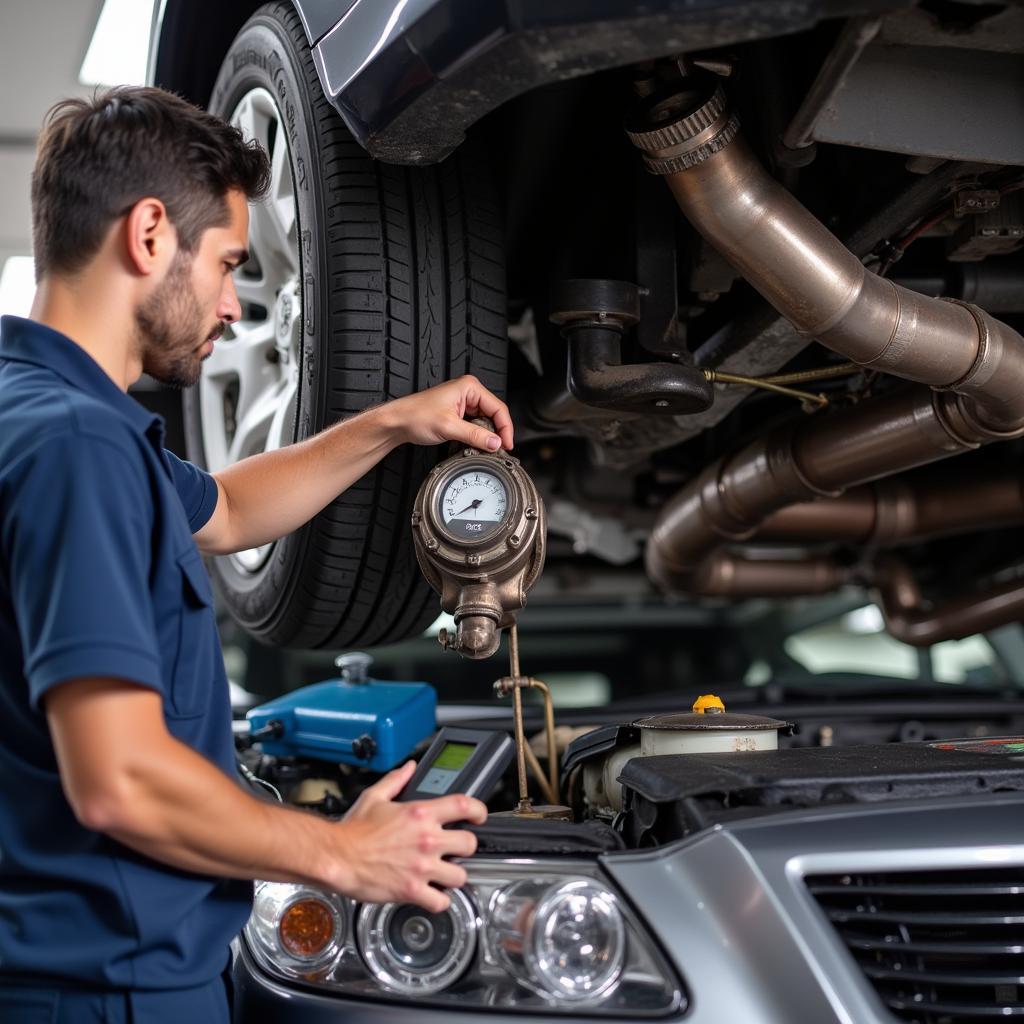Finding the right tool to scan if your car will pass emissions is crucial for avoiding costly repairs and ensuring your vehicle is roadworthy. Whether you’re a car enthusiast, a professional mechanic, or just a concerned car owner, understanding your vehicle’s emissions status is essential. This comprehensive guide will explore the various tools and techniques available to help you determine if your car will pass its emissions test.
Understanding Emissions Testing and Why It Matters
Emissions tests are designed to measure the amount of pollutants released by your vehicle’s exhaust system. These pollutants contribute to air pollution and can have serious health and environmental consequences. Passing an emissions test is often a legal requirement for vehicle registration in many regions.
Types of Tools to Scan if Car Will Pass Emissions
Several tools can help you gauge whether your car will pass emissions. These range from simple OBD-II scanners to professional-grade diagnostic equipment.
OBD-II Scanners: A Quick Check for Emissions Readiness
OBD-II (On-Board Diagnostics, Second Generation) scanners are readily available and affordable tools that can provide valuable insights into your car’s emissions system. These scanners plug into your car’s OBD-II port, typically located under the dashboard, and read diagnostic trouble codes (DTCs). While they don’t directly measure emissions output, they can identify potential issues that might cause your car to fail the test. For example, a faulty oxygen sensor or a malfunctioning catalytic converter can trigger DTCs that indicate emissions problems.
Professional-Grade Scan Tools: In-Depth Analysis for Mechanics
Professional mechanics and automotive technicians use more advanced scan tools that offer comprehensive diagnostic capabilities. These tools can access manufacturer-specific data, perform advanced tests, and provide detailed information about the various components of the emissions system. They can also perform bi-directional control tests, allowing mechanics to activate specific components to pinpoint the source of a problem.
 Professional Scan Tool for In-Depth Emissions Diagnosis
Professional Scan Tool for In-Depth Emissions Diagnosis
Will a Code Reader Tell Me if My Car Will Pass Emissions?
While a code reader can identify potential problems, it doesn’t guarantee a pass or fail result. A code related to the emissions system might indicate a problem, but it doesn’t necessarily mean your car will fail the actual emissions test. Conversely, the absence of codes doesn’t guarantee a pass. Some issues might not trigger a DTC but could still cause elevated emissions levels.
How to Use an OBD-II Scanner to Check for Emissions Readiness
Using an OBD-II scanner to check for emissions readiness is relatively simple. Plug the scanner into the OBD-II port, turn on the ignition (but don’t start the engine), and follow the scanner’s instructions to read the data. Look for information on emissions readiness monitors. These monitors track the performance of various emissions-related components. If all monitors are “ready” or “complete,” your car is more likely to pass the emissions test. However, incomplete monitors might indicate a potential issue that requires further investigation.
“Using an OBD-II scanner is like taking your car’s pulse. It can give you a general idea of its health but doesn’t provide a complete diagnosis,” says Alex Thompson, Senior Automotive Technician at Certified Auto Repair.
Beyond Scan Tools: Other Factors Affecting Emissions
Several factors besides those detectable by scan tools can affect your car’s emissions output. These include:
- Proper Maintenance: Regular maintenance, such as oil changes, spark plug replacements, and air filter cleaning, can help keep your car’s emissions system in good working order.
- Driving Habits: Aggressive driving can increase emissions.
- Fuel Quality: Using low-quality fuel can negatively impact emissions.
 Mechanic Checking Car Emissions System
Mechanic Checking Car Emissions System
Conclusion
Using a tool to scan if your car will pass emissions is a smart step towards ensuring your vehicle is environmentally friendly and compliant with regulations. While OBD-II scanners are useful for preliminary checks, professional-grade tools provide more comprehensive diagnostics. Remember that regular maintenance and responsible driving habits are also crucial for minimizing emissions and prolonging the life of your car’s emissions system. Ultimately, addressing potential issues proactively can save you time, money, and frustration in the long run.
FAQ
- What is an OBD-II scanner? An OBD-II scanner is a device that plugs into your car’s OBD-II port to retrieve diagnostic trouble codes and other data.
- Can I use an OBD-II scanner to guarantee I’ll pass emissions? No, it can only identify potential problems.
- What are emissions readiness monitors? These monitors track the performance of emissions components.
- What else affects my car’s emissions? Maintenance, driving habits, and fuel quality all play a role.
- Where can I get my car’s emissions tested? Check with your local Department of Motor Vehicles or equivalent agency.
- What happens if my car fails the emissions test? You will likely need to get the necessary repairs and retest the vehicle.
- How often do I need to get my car’s emissions tested? This varies by region; consult your local regulations.
Need help with car diagnostics? Contact us via WhatsApp: +1(641)206-8880, Email: [email protected] or visit us at 910 Cedar Lane, Chicago, IL 60605, USA. Our 24/7 customer service team is ready to assist you.

Leave a Reply